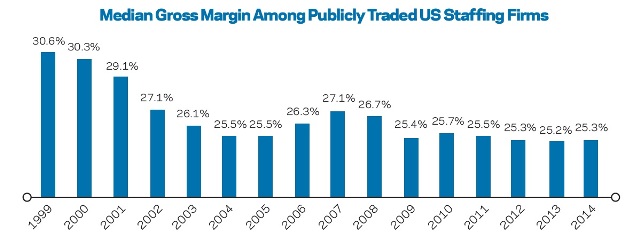Driven by margin pressure, divergent IT staffing models emerge
It’s high times for the IT staffing business. Literally so, when viewed in the context of the industry’s long-term growth, which shows the market ramping up to reach a new record scale for the fourth consecutive year in 2015, by our estimates. Enterprise demand remains historically robust for technologies from data analytics, to cloud, to mobile, to cybersecurity. Meanwhile, the labor market for high-level tech skills is growing ever tighter, with unemployment rates in many IT occupations at or below 2%. Against such a backdrop of abundant demand and limited supply, one might imagine that staffing suppliers are negotiating from a position of strength when it comes to bill rates. Surprisingly, however, the evidence doesn’t bear this out.
As seen in the accompanying chart, median industry gross margins for staffing have remained stubbornly in the low-20% range during the economy’s slow-but-steady emergence from the Great Recession. This is essentially the same level where they bottomed in the fallout from the dot-com bubble, which saw the industry contract by double-digit percentages in both 2001 and 2002.
So, what industry dynamics are playing out to prevent bill-pay spreads from expanding, as is generally necessary for gross margin growth, and what strategies are staffing firms deploying in response?
Dynamics. To the first part of that question, the high degree of penetration by managed service providers (MSPs) and vendor management systems (VMSs) in the IT staffing market, where buyers were some of the earliest and heaviest adopters, is likely the biggest factor. According to our surveys, more than half of all staffing spend in the US passes through a VMS, and IT makes up greater than one-third of that volume. This has the effect of intensifying price competition among suppliers, thereby moderating bill rate hikes and constraining supplier profitability.
Staffing’s response. Turning to the latter half of the query, we are seeing multiple — and in some senses opposing — models emerge. For those firms that have elected to stay on the path of supplying VMS, sometimes referred to as “wholesale” accounts, the upshot is the potential to reach a slew of large buyers with a minimum of sales and marketing expenditure. While this is can be a great way for a young company to rapidly grow sales, it requires a slimmed-down operating structure to do so profitably. After all, it is not revenue, but net income that is a company’s bottom line — literally! In addition to savings in the sales department, this strategy depends on a highly efficient and effective recruiting engine, often in the form of a centralized national hub, which may pair with an offshore recruiting operation in order to scour the landscape for candidates around the clock.
This is not to say that high margins aren’t possible in staff augmentation, but attaining them may involve the tradeoff of accepting a more modest revenue scale. Turning focus from large enterprise to mid-market, non-VMS (i.e., “retail”) clients can offer the opportunity to return to a direct client-supplier relationship where customer service brings a premium. While the potential sales per account will be far lower, and it will require more prospecting, this is an effective way to ward off the commoditization that is an inevitable result of competing purely on price.
But why can’t a staffing firm have its revenue cake and eat the profits too? This the case for the big tech consulting firms, which service the same client base, and operate on a revenue scale in the billions of dollars per company, yet show median gross margins in the mid-30% range — 10 to 15 percentage points higher than those of staffing firms. Well, the staffing industry has begun to take notice of this dynamic, with some attempting to move up the value curve into what is often referred to under the nebulous moniker of “solutions.” This involves the ability to execute IT projects or provide services on an ongoing basis under a statement-of-work (SOW), the document that formalizes the engagement, specifying details such as the activities to be performed, timeline for completion, minimum quality standards and the basis for pricing.
To be sure, entering the market for SOW-based projects and services is no easy task. Billing — even when priced under a time-and-materials model — is contingent upon the provision of deliverables and achievement of milestones. If a supplier is not able to fulfill its commitments under the SOW at the cost it has budgeted, the deal can quickly turn unprofitable. To compete effectively in this game, a company must have a robust delivery platform that is far more sophisticated than the typical back office of a staffing firm. Project managers and highlevel sales reps with significant subject matter expertise are a must. Perhaps most crucially, it must have clients that are willing to take the relationship to a higher level, despite having historically viewed you as “just” a staffing supplier.
Due to the significant operational and strategic differences between volume VMS supply and SOW-based services, it is quite difficult to combine the two effectively in a single organization. While large players in the industry have typically done so by creating autonomously managed business units, it may behoove small to midsize firms to choose one path toward which to devote their resources.







